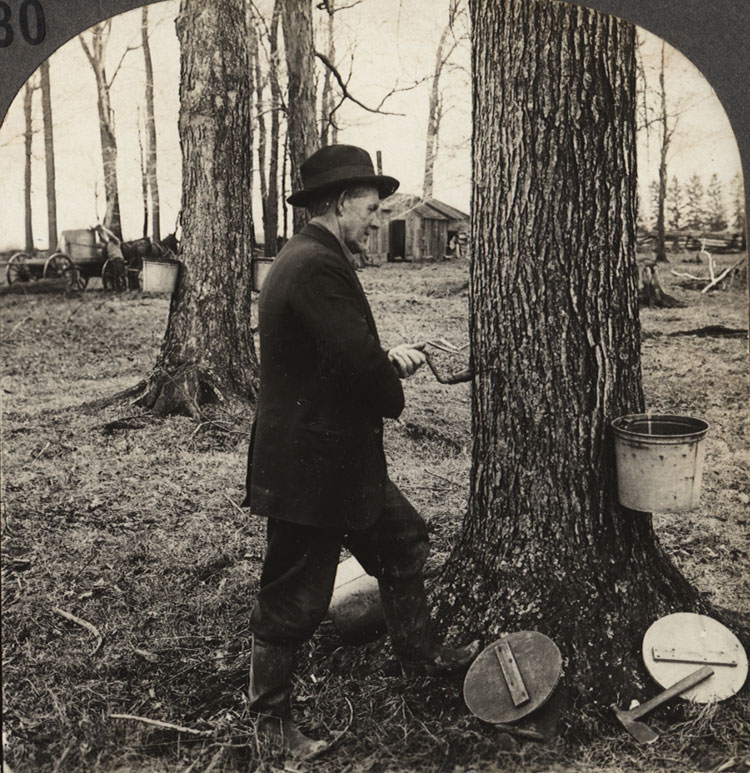
Stereoview of tapping sugar maple tree. Image source:private collection
The photo above shows all the elements of the maple syrup process: the sugar maple tree being drilled prior to having the spout tapped into hole with the small hatchet on the ground; the bucket hung on the spout with bucket covers at the ready. In the rear left is a wagon with the sap gathering tank being readied; and in the center rear is the sugar shanty, close to the sugar bush (stand of sugar maple trees), where the sap will be boiled to produce maple syrup. |
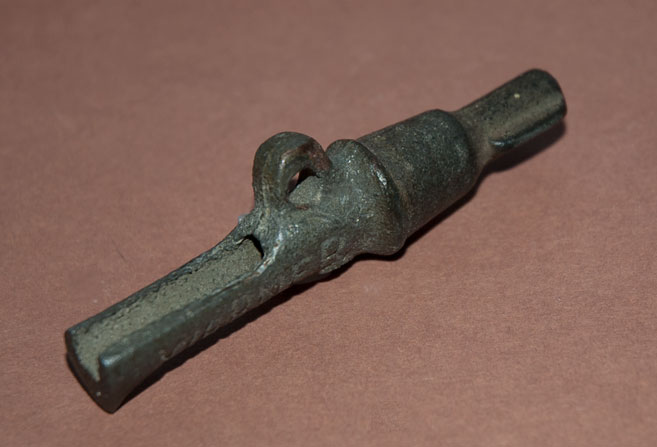
Old-fashioned cast iron spout used on the Eck farm. (Its hook below for hanging the can is missing.)
This Warner spout was patented in 1893.
Maple syrup was produced by Native Americans as their sweetener before the land was settled by pioneers. They determined that the sugar maple tree, a particular species that only grows in eastern North America, had a sweet sap. They collected sap by slashing a tree and collecting the sap during mid-March through mid-April each spring after the weather warmed enough to start the sap flowing in the sugar maple trees but before temperatures prompted the first leaf buds to expand. Pioneers found that maple syrup and its variant products such as granulated maple sugar were excellent substitutes for cane sugar that was impossible to obtain or impossibly expensive for subsistence farmers. Until the Civil War, maple syrup was the primary sweetener for the northeast. On the Eck farm in the hills of Wyoming county outside Attica, our dad started tapping in the family sugar bush when he figured the weather seemed right, with daytime temperatures in the 30's or 40's followed by cold nights. He hitched the horses, Dick and Daisy, to an articulated bobsled (a winter work sled), loaded it with stacks of cans, a hand drill, hammer, and spouts and began the slow trek through the woods, tapping trees and hanging buckets for hours at a time on the snow-covered, uneven ground. By the time we sold the farm in 1978, our family was tapping 500 trees in our woods each year, and collecting sap from those trees repeatedly over 4-6 weeks. |
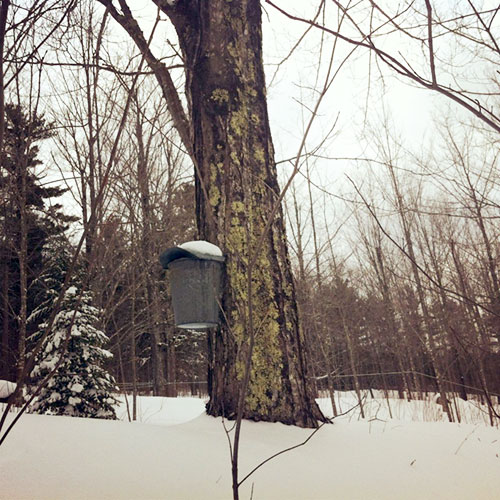
Galvanized sap can with metal cover, like thosed used in the Eck farm.
Image source: The Portland Press
In the northeast U.S., it was common for farm families with a sugar bush on their land to make maple syrup in the early spring; during this time of year the demand of other farm activities was light. Producing a barrel or two of maple syrup for family use over the year was helpful to the family food budget. On the Eck farm, we had a cottage business of selling syrup to individuals out of town. Through relatives and their friends scattered around the country, our mother maintained a handwritten list of names and addresses of people who bought a gallon or two of our maple syrup year after year. |
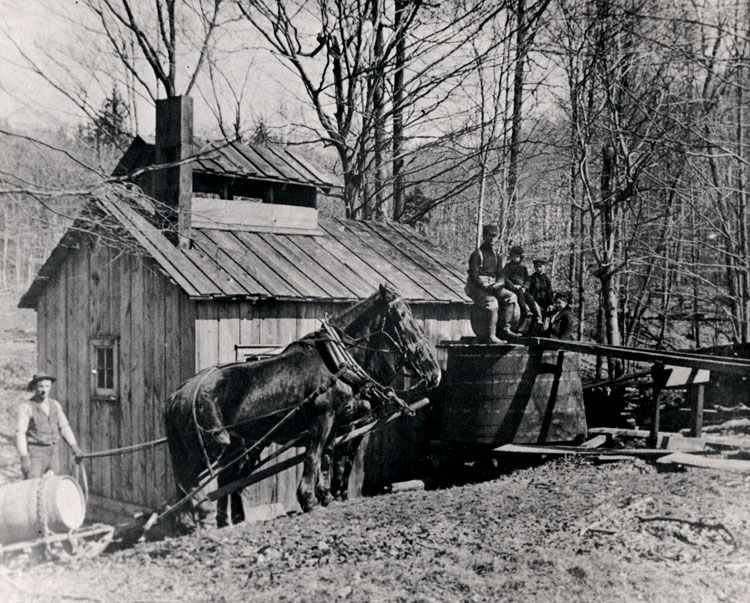
A typical sugar shanty from the early 20th century. Image source: TBHM
People called the structures in their woods which they used for a month or so each year by deservedly humble names: sugar shack or sugar shanty. Whatever material was at hand or could be crafted was used to create the exterior of the maple syrup boiling house. It needed to keep out the precipitation, have a large open cupola to vent the steam, and a taller smokestack to vent the wood smoke from the roaring fire that boiled the sap. Ideally, it was located on a slope, as seen above and in the photo below, so that gravity would supply sap from the holding tank (on which are seated four above) into the evaporators inside the shanty. Like the shanty above, the Eck sugar shanty, seen below, seemed to exist in a time warp, as if we stepped back into the 1930s. There was no electricity or running water (except for a spring down the hill). The only seating was an unwanted Victorian fainting couch which had a missing leg for which a piece of firewood substituted. And the main supply stored in the shanty was a wall of dry firewood, which the hearth required at regular intervals. Taking up the most space in the shanty was a very long cast iron arch, i.e. a fire box, which accepted firewood cut in 3-ft lengths. The fire boiled the sap pan nearest the hot end of the arch and warmed two other pans of sap as the smoke and heat passed under them on the way to the smokestack. It was exceptionally efficient because when the hottest sap reached syrup stage (determined by experience), it was syruped off, i.e. poured into 10-gallon steel milk cans (for later transportation down to the house). Then a plug closing off the second, very warm, pan of sap, was removed, passing that sap into the hottest pan. The plug was replaced, Similarly, a plug that closed off the third pan, was removed, filling the second pan. Then dad would refill the third pan with sap from the steel holding tanks outside the shanty and up the slope which were in the same position as the wooden barrel in the photo above. |
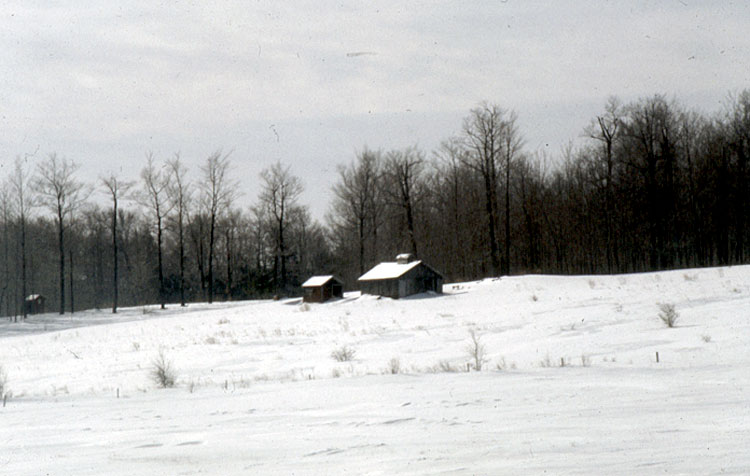
Eck sugar shanty, c 1978.
The smoke stack was stored inside the shanty out of season.
Captions are mine.
The sugar shanty was a welcome, warm place to enter after a sap gathering trip in the raw March weather. Mittens wet from pulling ice from the buckets of sap would visibly steam dry if placed near the arch. The sugar shanty in full operation was a pleasant mix of the smell of wood smoke, wool, and the intense, flavorful perfume of maple syrup. This last was prevalent inside the shanty because the steam from the evaporators freely rose to the cupola and contained sugar that clung to one's hair more stiffly than any hair spray. We learned to keep our heads covered when in the sugar shanty! In the mid-1960s, our grandfather would be stationed on the fainting couch while the family was out on the bobsled collecting sap; his job was to feed the fire to keep the sap boiling. It takes 30-50 gallons of sap to make 1 gallon of syrup, depending on the sugar content of the sap.. |
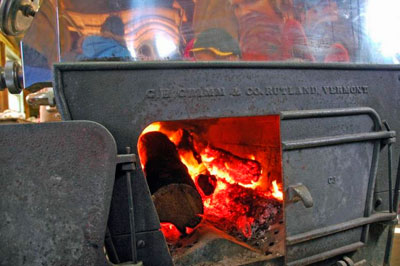 Old-fashined arch for boiling sap; this is identical to the one used on the Eck farm. Image source: Mary Byrom, The Epoch Times |
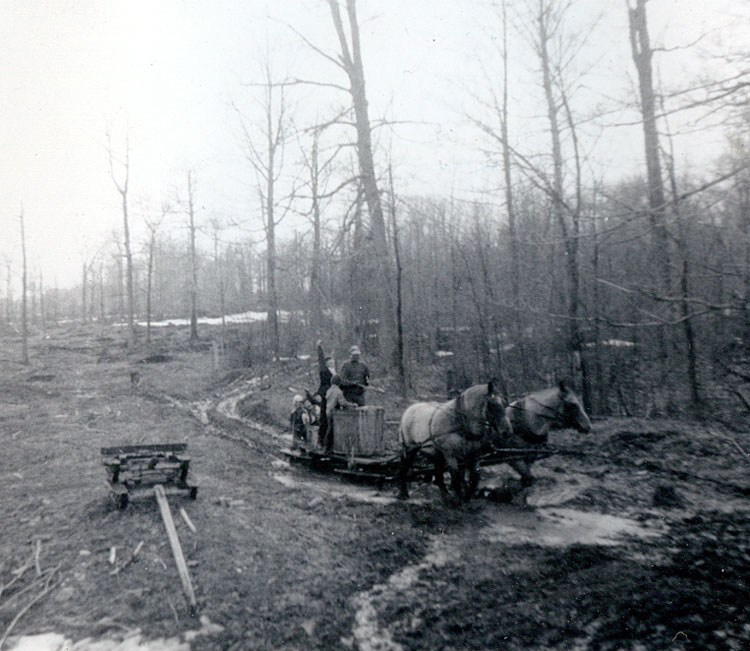
Eck family photo, c, 1965
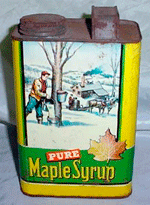 Gallon Maple Syrup can style used on the Eck farm, c, 1960s. Image source: eBay |
On a family farm, children contribute such labor as their age and abilities allow. When maple syrup season came around, our parents collected sap by themselves during the week, augmented at times by us when we got home from school and the sap was running strong. On weekends, we all went up the hill to the shanty and stayed much of the day. When both the steel storage tanks were full, dad would walk up the hill with a kerosene lantern in the dark after chores were finished and feed the fire for several hours. Sometimes our parents would invite good friends to spend an evening with snacks and beverages in the shanty while the sap boiled. To make 15 gallons of syrup, the arch would consume a cord of wood ( 4x4x8 feet). The short maple syrup season was first in our priorties and then, quickly, it was over. The buckets were collected, dried and stacked in the little building beside the shanty. The spouts were removed and the trees closed their little 1/2" wounds as they had for decades and proceeded with their growing season. Our family sent out enough maple syrup, in gallon and half-gallon cans identical to that at left, to make around $1,000 a year. We children complained about the labor of carrying full cans of sap to the tank on the bobsled, slipping into dips and stepping into invisible holes on the way. We sloshed ice cold sap into our boots, soaked our backup mittens, clung desperately to the bobsled as the horses navigated gullies and curves in the woods never intended for any kind of vehicle. But we understood that this was a necessary family task. Now we tell the next generation about this and the lunches at the shanty, of eggs hard boiled in the sap, and sardines with crackers. In the photo above, dad is driving the bobsled as it nears the shanty with a full tank of collected sap. Mom is waving at me, balanced on the metal roof of the shanty. I was no doubt delighted to have been left behind on that sap collecting trip.
|














